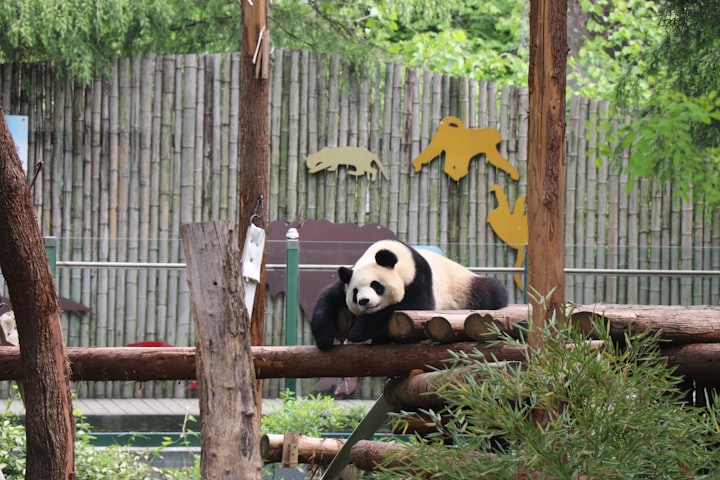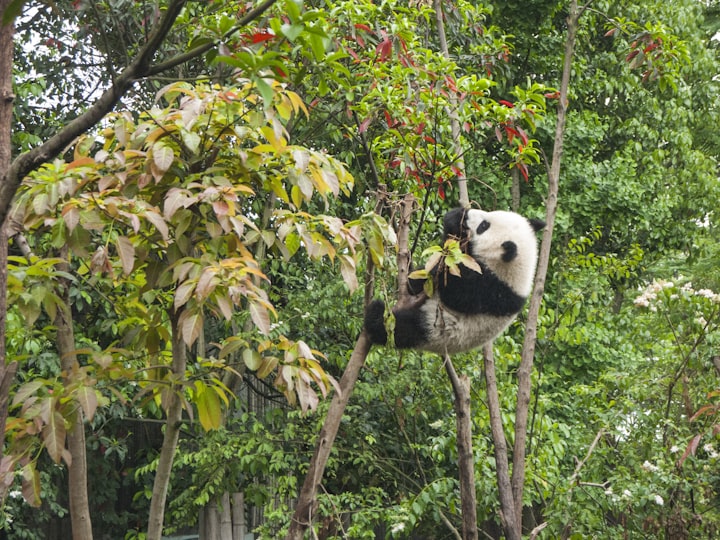How high is the reward for protecting giant pandas?
What does it really mean to save a species?
Because extinction is always present in nature, and no species is necessarily "indispensable," the motivation to protect biodiversity always seems less than "sufficient. Unless, of course, it is "profitable" for humans to do so.
Recently, the international journal Modern Biology published a paper, "The Value of Ecosystem Services from Giant Panda Reserves," in which the conservation value of the giant panda as a flagship species for endangered conservation in China was assessed quantitatively for the first time --- $2.6 billion return on an annual investment of $255 million!
Calculating the cost of giant panda conservation
Born to be unique, cute, adorable, and a national symbol, the giant panda receives a level of attention that is unparalleled. This unparalleled appeal has eventually translated into more conservation funding and policy support.
Over the past 40 years, 67 nature reserves have been established in China to save giant pandas, covering a total area of 33,118 square kilometers, covering 54.7% of the giant panda's range. The number of wild giant pandas has also recovered from 1,112 in 1990 to 1,864 in 2010.
Wei Fun, an academician of the Chinese Academy of Sciences, researcher at the Institute of Zoology of the Chinese Academy of Sciences, and corresponding author of the paper has been engaged in research on the conservation biology of giant pandas, during which he would hear from time to time public opinion fuming - is it worth spending a lot of money on giant panda conservation?
One of the most extreme statements came from Chris Packham, a BBC nature presenter. He has publicly stated that pandas as a species have reached a dead end in their biological evolution and should be left to fend for themselves and that the money spent on panda conservation should be better spent on helping other species. However, such statements have been criticized from all sides.
In September 2016, the IUCN published a new version of the IUCN Red List of Threatened Species, which moved the giant panda from "endangered" to "vulnerable," reigniting the public debate over the investment in species conservation. The change from "endangered" to "vulnerable" in the Red List of Endangered Species of the Alliance for the Conservation of Endangered Species has once again sparked public debate on the investment in the conservation of this species.
In January 2016, before the giant panda was "downgraded", he convened experts from home and abroad to hold a workshop on the value of giant panda ecosystem services in Chengdu, Sichuan. "In January 2016, before the giant panda was downgraded, he convened experts from home and abroad to hold a workshop on the value of ecosystem services for giant pandas in Chengdu, Sichuan. The purpose of the meeting was to quantify and compare the inputs and outputs of conservation, and to make a clear accounting for giant panda conservation. Everyone benefits from giant panda conservation
There is no one way in the world to calculate the ultimate value of any organism, but the object of species conservation is not just the species itself, but also the habitat and ecosystem on which this species depends.
Hu Yibo, a researcher at the Institute of Zoology of the Chinese Academy of Sciences and one of the authors of the paper, told China Science News that since the implementation of the Wildlife Protection Law in 1988, threats to the pandas themselves such as poaching and hunting have been rare. The main survival problem they face is habitat loss and fragmentation due to forest logging, mining, farming, human settlements, infrastructure, etc. The national investment in giant panda conservation is also basically used to protect the environment on which giant pandas depend, thus reducing the impact of habitat loss and fragmentation. Therefore, most of the value generated by giant panda conservation comes from the service value of the protected habitats and forest ecosystems.
The term "ecosystem services" refers to all the benefits that humans derive from ecosystems, including the value of provisioning services, regulating services, and cultural services.
From this study, we can see that the Giant Panda Reserve provides a variety of supply services necessary for local people, such as crop cultivation, grazing, access to water, firewood and useful plants, etc. Important regulating services include regulation of hydrological flows, sediment conservation, carbon sequestration, nutrient storage, etc.
Researchers compiled estimated values for these services from numerous studies and converted all estimates to 2010 dollar values. They used the median value of each service to estimate the annual value per hectare for all supply and regulating services associated with the panda reserve combined, and this estimate was $632/ha/year. This value was multiplied by the number of forested areas in the reserve to give the total value of supply and regulation services in the panda reserve at different points in time. The results show that this amount increased from US$ 562 million/year in 1980 to US$ 1,899 million/year in 2010.
The cultural services of ecosystems are more specific in that they include the value of visiting tourism and recreational activities, as well as aesthetic, artistic, educational, and spiritual values. In addition, as an iconic protected species worldwide, images of pandas are often borrowed for commercial product development and brand logo design, such as panda-themed restaurants (Panda Express), movies (Kung Fu Panda), and video games (World of Warcraft); some NGOs have also incorporated panda images into their logos to help fundraising efforts for various conservation projects. The revenue generated from this is not to be underestimated. However, it is difficult to determine what percentage of this revenue is attributable to the panda image.
Therefore, Hu Yibo explains that in this study, the researchers' calculation of the value of cultural services is ultimately based on the value generated by the public's love for pandas and their willingness to pay voluntarily to protect them.
The article points out that the value of cultural services limited to serving the Chinese population and the population of Organization for Economic Cooperation and Development (OECD) member countries visiting China is $709 million, so the total value of ecological services for giant pandas and their habitat is $2.6 billion; if the value of cultural services is extended to the global population, the total value of ecosystem services would be as high as $6.9 billion.
It is estimated that the total investment in giant panda conservation in 2010 was about US$255 million, which means that the output of giant panda conservation is 10~27 times more than its invested capital.
Not only that, according to the China Statistical Yearbook, the annual income growth rate of farmers near protected areas in Sichuan, Shaanxi, and Gansu, provinces with giant pandas, was 8% more than the average growth rate of farmers in the province from 2000 to 2010. This investment in conservation has also improved the material living conditions of residents.
A good environment is not free
Another important researcher involved in the design and drafting of the study was the renowned ecological economist Robert Costanza, who is 1997, together with 13 other scientists, produced the first estimate of the value of global ecosystem services and natural capital, setting off a wave of research on the value of ecosystem services.
Twenty years later, Costanza's estimates of global ecosystem services have grown from $33 trillion/year to $125 trillion/year. Although these are conservative valuations, for now, the contribution of ecosystem services to human well-being has reached more than twice the global GDP.
Hu Yibo admits that in the field of conservation biology in China, the concept of "conservation of flagship species" and "umbrella species" has been increasingly recognized. However, the perception of "ecosystem service value" is not as widespread.
Even in the field of ecology, it has taken a long time to truly recognize the function of ecosystem services and the need to put a price on these services.
This is because clean air and water, soil formation, climate regulation, waste disposal, physical health, and art and aesthetics, to name a few, are ecosystem services that contribute to human well-being in large part only like purely public goods, and they are not valued at all through the monetary economy.
"It has been our traditional perception that something without human labor involved is worthless, or that only things that can be traded in the marketplace have value." Xie Gaogao, deputy director and chief researcher of the Resource Science Center of the Institute of Geographical Sciences and Resources of the Chinese Academy of Sciences, talked in an interview with China Science News, "In many cases, we simply do not realize the existence of the value of ecosystem services and think that the environment on which humans depend is free!"
Only in one case does such a perception change, and that is to determine how much it would cost to replicate such services in a man-made biosphere created through a process.
Forest-covered river basins can intercept and purify rainwater, which is then sent to lakes and seas. Until the 1990s, New York City enjoyed the pure water of the Catskills. But as the population grew, a large amount of forest land became farms and houses, producing sewage and wastewater that soon contaminated the water and made it impossible to meet drinking water standards.
Before the government is two options: they can spend $6 billion to $8 billion to build a water purification plant, and down the road, there is about $300 million a year in maintenance costs; otherwise, invest $1 billion to rebuild the Catskill forests. As you can see, for one water service alone, the value of the forest ecosystem output is several times the value of its conservation dollars.
No management without measurement
"The Giant Panda Reserve is an example that has attracted a great deal of interest because of its iconic status. The giant panda is an 'umbrella species' that has allowed the establishment of protected areas that provide a range of valuable ecosystem services." Costanza said in an interview with Science China.
According to him, "this study shows that the value to society of investing in the conservation and restoration of natural capital is enormous and far outweighs the costs." This also means that the relatively large financial outlay to put pandas on the road to recovery is justified.
Today, habitat fragmentation and degradation are still considered to be the most critical factors limiting the recovery of giant pandas. The study also predicts that a 15% expansion of the nature reserve area and a 15% increase in conservation managers over the next 20 years would increase input costs to $292 million, while total benefits would increase to $3.22 billion, with a higher benefit-to-cost ratio than today. Conversely, if economic growth slows and conservation inputs, conservation managers and forests decrease, then 20 percent of the giant panda's habitat will be destroyed.
However, Xie Heights also mentioned that although the academic community has been focusing on and studying how we can better value ecosystem services for these 20 years, there are still many uncertainties in the process.
On the one hand, the composition of ecosystem services is extremely complex and the functioning is a dynamic process; on the other hand, the prices in alternative markets are volatile. It will take a long time to establish a system as stable as the worldwide recognized GDP accounting system.
At present, there are various kinds of methods for valuing ecosystem services, and the system of indicators for valuing ecosystem services is not perfect and uniform, and the results of valuing ecosystem services in a region are inevitably subject to disagreement. However, none of this hinders the broad prospect of applying ecosystem service valuation.
Modern management science emphasizes that if we can't measure something, we can't manage it. According to Hu Yibo, ecosystem service value assessment not only provides a good visual understanding of the direct and indirect benefits of species and biodiversity conservation from the scientific level but also helps decision-makers and the public understand the significance of biodiversity conservation from the economic perspective. More importantly, as Costanza says, assessments are inextricably linked to the choices and decisions we must make about ecosystems.
About the Creator
Turnell Feliu
People who shiver from the cold can best appreciate the warmth of the sun. Those who have experienced life's troubles know best the preciousness of life







Comments (1)
You're amazing.